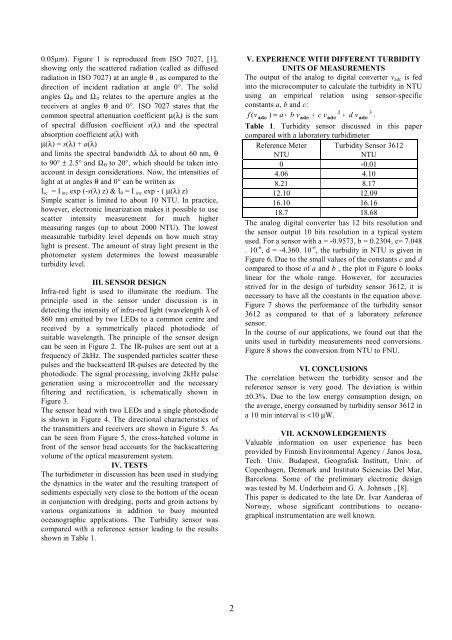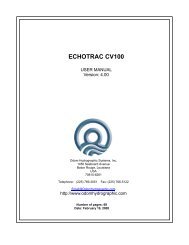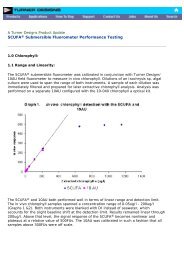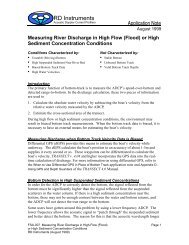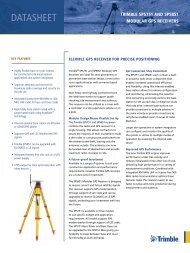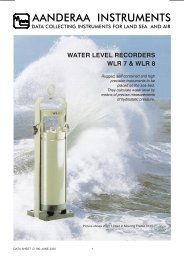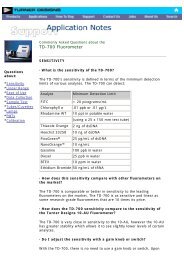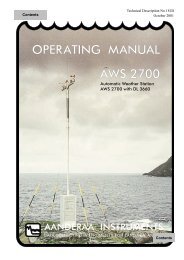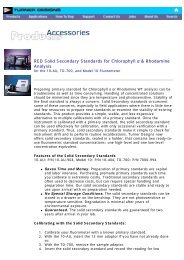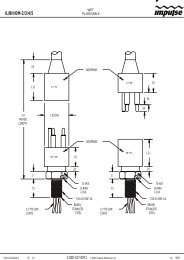TURBIDITY SENSOR FOR UNDERWATER APPLICATIONS Sensor ...
TURBIDITY SENSOR FOR UNDERWATER APPLICATIONS Sensor ...
TURBIDITY SENSOR FOR UNDERWATER APPLICATIONS Sensor ...
Create successful ePaper yourself
Turn your PDF publications into a flip-book with our unique Google optimized e-Paper software.
0.05µm). Figure 1 is reproduced from ISO 7027, [1],<br />
showing only the scattered radiation (called as diffused<br />
radiation in ISO 7027) at an angle θ , as compared to the<br />
direction of incident radiation at angle 0°. The solid<br />
angles Ω θ and Ω 0 relates to the aperture angles at the<br />
receivers at angles θ and 0°. ISO 7027 states that the<br />
common spectral attenuation coefficient µ(λ) is the sum<br />
of spectral diffusion coefficient s(λ) and the spectral<br />
absorption coefficient a(λ) with<br />
µ(λ) = s(λ) + a(λ)<br />
and limits the spectral bandwidth ∆λ to about 60 nm, θ<br />
to 90° ± 2.5° and Ω θ to 20°, which should be taken into<br />
account in design considerations. Now, the intensities of<br />
light at at angles θ and 0° can be written as<br />
I sc = I inc exp (-s(λ) z) & I 0 = I inc exp - ( µ(λ) z)<br />
Simple scatter is limited to about 10 NTU. In practice,<br />
however, electronic linearization makes it possible to use<br />
scatter intensity measurement for much higher<br />
measuring ranges (up to about 2000 NTU). The lowest<br />
measurable turbidity level depends on how much stray<br />
light is present. The amount of stray light present in the<br />
photometer system determines the lowest measurable<br />
turbidity level.<br />
III. <strong>SENSOR</strong> DESIGN<br />
Infra-red light is used to illuminate the medium. The<br />
principle used in the sensor under discussion is in<br />
detecting the intensity of infra-red light (wavelength λ of<br />
860 nm) emitted by two LEDs to a common centre and<br />
received by a symmetrically placed photodiode of<br />
suitable wavelength. The principle of the sensor design<br />
can be seen in Figure 2. The IR-pulses are sent out at a<br />
frequency of 2kHz. The suspended particles scatter these<br />
pulses and the backscatterd IR-pulses are detected by the<br />
photodiode. The signal processing, involving 2kHz pulse<br />
generation using a microcontroller and the necessary<br />
filtering and rectification, is schematically shown in<br />
Figure 3.<br />
The sensor head with two LEDs and a single photodiode<br />
is shown in Figure 4. The directional characteristics of<br />
the transmitters and receivers are shown in Figure 5. As<br />
can be seen from Figure 5, the cross-hatched volume in<br />
front of the sensor head accounts for the backscattering<br />
volume of the optical measurement system.<br />
IV. TESTS<br />
The turbidimeter in discussion has been used in studying<br />
the dynamics in the water and the resulting transport of<br />
sediments especially very close to the bottom of the ocean<br />
in conjunction with dredging, ports and groin actions by<br />
various organizations in addition to buoy mounted<br />
oceanographic applications. The Turbidity sensor was<br />
compared with a reference sensor leading to the results<br />
shown in Table 1.<br />
V. EXPERIENCE WITH DIFFERENT <strong>TURBIDITY</strong><br />
UNITS OF MEASUREMENTS<br />
The output of the analog to digital converter v adc is fed<br />
into the microcomputer to calculate the turbidity in NTU<br />
using an empirical relation using sensor-specific<br />
constants a, b and c:<br />
f ( v ) = a + b v + c v + d v<br />
2<br />
adc adc adc adc<br />
3 .<br />
Table 1. Turbidity sensor discussed in this paper<br />
compared with a laboratory turbidimeter<br />
Reference Meter Turbidity <strong>Sensor</strong> 3612<br />
NTU<br />
NTU<br />
0 -0.01<br />
4.06 4.10<br />
8.21 8.17<br />
12.10 12.09<br />
16.10 16.16<br />
18.7 18.68<br />
The analog digital converter has 12 bits resolution and<br />
the sensor output 10 bits resolution in a typical system<br />
used. For a sensor with a = -0.9573, b = 0.2304, c= 7.048<br />
. 10 -6 , d = -4.360. 10 -6 , the turbidity in NTU is given in<br />
Figure 6. Due to the small values of the constants c and d<br />
compared to those of a and b , the plot in Figure 6 looks<br />
linear for the whole range. However, for accuracies<br />
strived for in the design of turbidity sensor 3612, it is<br />
necessary to have all the constants in the equation above.<br />
Figure 7 shows the performance of the turbidity sensor<br />
3612 as compared to that of a laboratory reference<br />
sensor.<br />
In the course of our applications, we found out that the<br />
units used in turbidity measurements need conversions.<br />
Figure 8 shows the conversion from NTU to FNU.<br />
VI. CONCLUSIONS<br />
The correlation between the turbidity sensor and the<br />
reference sensor is very good. The deviation is within<br />
±0.3%. Due to the low energy consumption design, on<br />
the average, energy consumed by turbidity sensor 3612 in<br />
a 10 min interval is


